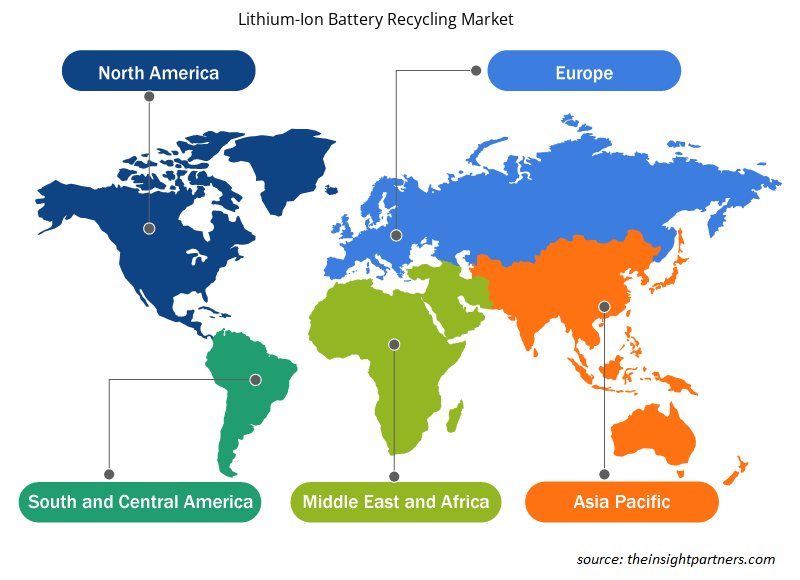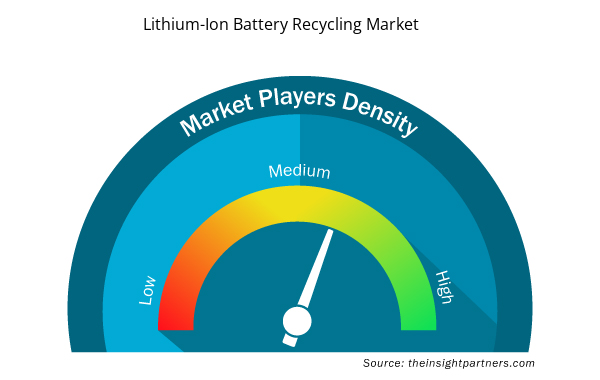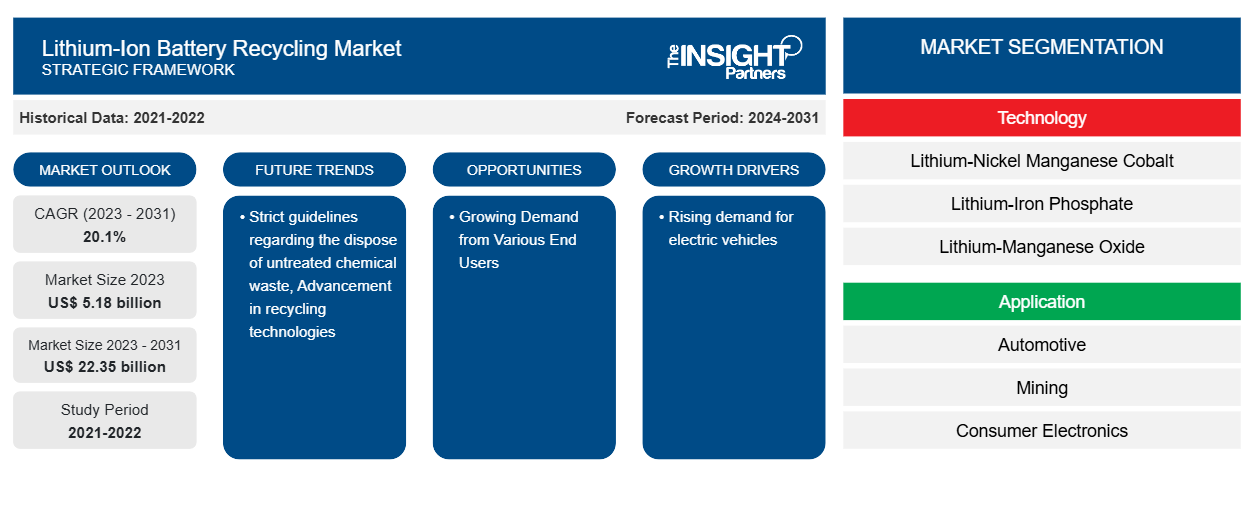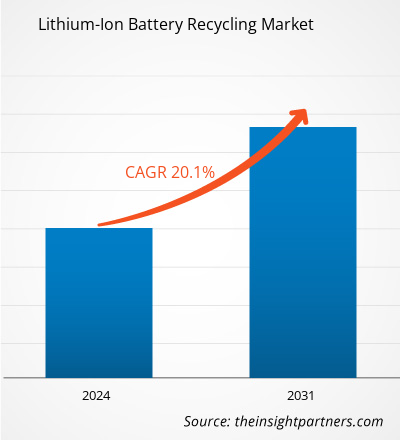リチウムイオン電池リサイクル市場規模は、2023年の51億8,000万米ドルから2031年には223億5,000万米ドルに拡大すると予想されており、2023年から2031年にかけて年平均成長率20.1%で成長すると予測されています。未処理の化学廃棄物の処分に関する厳格なガイドラインとリサイクル技術の進歩は、今後もリチウムイオン電池リサイクル市場の主要トレンドであり続けると思われます。
リチウムイオン電池リサイクル市場分析
自動車業界では近年、特に米国、ドイツ、スウェーデン、ノルウェー、オランダ、中国、および東南アジアのいくつかの発展途上国で、リサイクルされたリチウムイオン電池の需要が大幅に増加しています。IEAの報告によると、2020年と比較して、2021年の電気自動車の販売台数はほぼ2倍の660万台(約9%)となり、全体で1,650万台の電気自動車が路上を走行しています。さらに、IEAは2030年までに3億台を超える電気自動車が路上 を走行すると予測して おり、リチウムイオン電池のリサイクルが増加する可能性があります。本質的には、この地域の発展途上国の電気自動車が環境に与える良い影響に関する消費者の知識が高まることで、業界の成長が促進されると予想されています。メーカーは、自動車での需要を満たすために、使用済みリチウムイオン電池のリサイクルに注力しています。
リチウムイオン電池リサイクル市場概要
リチウムイオン電池(LIB)は、さまざまな用途の発電をサポートする電極や触媒などのコンポーネントを含む電気化学セルの一種です。カソードとアノードのチューブには、埋蔵量が限られており、再販価格が高いさまざまな貴金属が含まれています。その結果、リチウムイオン電池のリサイクルプロセスは、電極構成で収集された原材料を回収して販売するために使用され、全体的なプロジェクトコストと影響が低減されます。これらの原因は、 リチウムイオン電池リサイクル市場の成長に役立ちます。
リチウムイオン電池がさまざまな用途でますます使用されるようになり、この基礎金属の供給が限られているのではないかという懸念が高まっています。この金属の採掘は、化学物質の漏出による水質汚染など、環境に悪影響を及ぼします。このため、最近ではリチウムイオン電池のリサイクルが増加しています。さらに、現在リチウムと同様の特性を持つ材料は他にないため、電池メーカーは、さまざまな用途の電池に適切な量の金属を提供するために、リチウム電池の再利用にますます重点を置いています。この点で、ドイツの化学会社BASFは、2021年6月にシュヴァルツハイデの正極活物質(CAM)施設に新しい電池リサイクルおよびプロトタイプ製造工場の建設を開始する計画を発表しました。リチウムイオン電池が耐用年数に達すると、同社は強化された方法を使用してコバルト、マンガン、リチウム、ニッケルを抽出する予定です。
要件に合わせてレポートをカスタマイズする
このレポートの一部、国レベルの分析、Excelデータパックなど、あらゆるレポートを無料でカスタマイズできます。また、スタートアップや大学向けのお得なオファーや割引もご利用いただけます。
- このレポートの主要な市場動向を入手してください。この無料サンプルには、市場動向から見積もりや予測に至るまでのデータ分析が含まれます。
リチウムイオン電池リサイクル市場の推進要因と機会
電気自動車の需要増加が市場成長を後押し
電気自動車の人気の高まりは、リチウムイオン電池リサイクル市場を牽引する主な要因の 1 つです。電気自動車の製造および販売量が増加するにつれて、寿命が尽きた電池をリサイクルする必要性はますます重要になっています。環境問題と温室効果ガス排出の影響に対する共通の認識により、よりクリーンで持続可能な輸送手段への世界的な動きがあります。電気自動車は、排出ガスがゼロであるため、従来の内燃機関に代わる現実的な選択肢であることが証明されています。電池技術と電気自動車の設計が継続的に改善されたことで、走行距離が延び、充電時間が短縮され、電気自動車の全体的な性能が向上しました。これにより、電気自動車はより実用的で、より幅広い層にとって魅力的になり、需要が高まっています。電気自動車におけるリチウムイオン電池の有用性は高まっています。電気自動車の利用は、エネルギー効率の低下、汚染、消費者の受け入れなど、リチウムイオン電池の採用を促進する要因の 1 つであるさまざまな要因により増加しています。高度な電池技術の開発とこれらのリチウムイオン電池のメンテナンス要件が最小限であることも、電気自動車の成長に貢献しています。そのため、リチウムイオン電池の使用増加に伴い、リチウムイオン電池リサイクル市場は今後も拡大すると予想されます。
BILITI Electricの推計によると、米国には約300万台(55,555台)の電気自動車があり、これは路上を走る自動車総数の約1%に相当します。2022年だけでも、55,555社が約442,000台の電気自動車を生産しました。これは、自動車メーカーによる電気自動車の生産が大幅に増加していることを示しています。
多様なエンドユーザーからの需要拡大 - リチウムイオン電池リサイクル市場におけるビジネスチャンス
電気・電子部門は、タブレット、コンピューター、携帯電話、その他の電子機器に使用されているため、リチウムイオン電池の最大のユーザーです。電気・電子産業の拡大により、これらのエネルギー源の需要は増加しており、特に中国、インド、日本などの成長中のアジア太平洋諸国で増加しています。さらに、リサイクルされたリチウムイオン電池の市場は、エンドユーザー産業からの需要の増加により、今後数年間で拡大する大きな可能性があります。さらに、いくつかの政府は、高度な電池リサイクル技術を導入しています。たとえば、2023 年 6 月、米国エネルギー省 (DOE) は、消費財からの電池のリサイクル、先進的な電池研究開発 (R&D) の協力体制の構築、および 2019 年に設立されたリチウムイオン電池リサイクル賞の継続のために 1 億 9,200 万ドル以上の追加資金を発表しました。電気自動車 (EV) と定置型エネルギー貯蔵の需要は2027 年までに 10 倍以上に増加すると予想されており、重要な材料の安全で回復力のある循環型国内サプライ チェーンをサポートするには、持続可能で低コストの消費者向け電池リサイクルに投資することが重要です。
リチウムイオン電池リサイクル市場レポートのセグメンテーション分析
リチウムイオン電池リサイクル市場分析の導出に貢献した主要なセグメントは、技術とアプリケーションです。
- 技術に基づいて、リチウムイオン電池のリサイクル市場は、リチウムニッケルマンガンコバルト、リチウムリン酸鉄、リチウムマンガン酸化物、リチウムチタン酸化物、リチウムニッケルコバルトアルミニウム酸化物に分類されます。
- 用途に基づいて、リチウムイオン電池のリサイクル市場は、自動車、鉱業、民生用電子機器、産業、電力に分類されます。
地域別リチウムイオン電池リサイクル市場シェア分析
- リチウムイオン電池リサイクル市場は、北米、ヨーロッパ、アジア太平洋(APAC)、中東・アフリカ(MEA)、南米・中米の5つの主要地域に分かれています。2023年にはAPACが市場を支配しました。
- GSユアサコーポレーション、ユミコアSAなど、革新的で著名なサプライヤーがこの地域に存在したことが、市場の急速な拡大につながっています。電気自動車や商業・住宅用エネルギー貯蔵システム(ESS)などの魅力的な新市場の出現が、LIBの需要を牽引しています。さらに、ESSと風力、太陽光、水力などの再生可能エネルギーを組み合わせて使用することは、グリッドの安定性を高め、LIBセグメントを発展させるために、技術的にも経済的にも不可欠です。
リチウムイオン電池リサイクル市場の地域別分析
予測期間を通じてリチウムイオン電池リサイクル市場に影響を与える地域的な傾向と要因は、Insight Partners のアナリストによって徹底的に説明されています。このセクションでは、北米、ヨーロッパ、アジア太平洋、中東、アフリカ、南米、中米にわたるリチウムイオン電池リサイクル市場のセグメントと地域についても説明します。

- リチウムイオン電池リサイクル市場の地域別データを入手
リチウムイオン電池リサイクル市場レポートの範囲
| レポート属性 | 詳細 |
|---|---|
| 2023年の市場規模 | 51億8000万米ドル |
| 2031年までの市場規模 | 223.5億米ドル |
| 世界のCAGR(2023年~2031年) | 20.1% |
| 履歴データ | 2021-2022 |
| 予測期間 | 2024-2031 |
| 対象セグメント | テクノロジー別
|
| 対象地域と国 | 北米
|
| 市場リーダーと主要企業プロフィール |
|
市場プレーヤーの密度:ビジネスダイナミクスへの影響を理解する
リチウムイオン電池リサイクル市場は、消費者の嗜好の変化、技術の進歩、製品の利点に対する認識の高まりなどの要因により、エンドユーザーの需要が高まり、急速に成長しています。需要が高まるにつれて、企業は提供を拡大し、消費者のニーズを満たすために革新し、新たなトレンドを活用し、市場の成長をさらに促進しています。
市場プレーヤー密度とは、特定の市場または業界内で活動している企業または会社の分布を指します。これは、特定の市場スペースに、その規模または総市場価値と比較して、どれだけの競合相手 (市場プレーヤー) が存在するかを示します。
リチウムイオン電池リサイクル市場で事業を展開している主要企業は次のとおりです。
- エコバットテクノロジーズ
- アメリカンマンガン株式会社(RecycLico Battery Material Inc.)
- フォータム
- 株式会社GEM
- 国際金属再生会社 (INMETCO)
- 株式会社リサイクル
免責事項:上記の企業は、特定の順序でランク付けされていません。

- リチウムイオン電池リサイクル市場のトップキープレーヤーの概要を入手
リチウムイオン電池リサイクル市場のニュースと最近の動向
ピアツーピア保険市場は、重要な企業出版物、協会データ、データベースを含む一次調査と二次調査後の定性的および定量的データを収集することによって評価されます。以下は、リチウムイオン電池リサイクル市場の動向の一覧です。
- 2024年2月、オメガセイキ・プライベート・リミテッド(OSPL)は、リチウムイオン電池のリサイクルに関してアテロと契約を締結したと発表した。この協力の下、OSPLは電子廃棄物管理会社アテロとともに、今後3~4年で100MWhを超える電池をリサイクルする計画だ。
(出典:オメガ精機株式会社、プレスリリース)
- 2024年5月、リチウム金属電池メーカーのSES AI Corp.(ボストン)は、ウースター工科大学(WPI)の新しい研究イニシアチブに資金を提供し、リチウム金属電池の「最先端」のリサイクル技術を開発する計画を発表しました。
(出典:SES AI Corp、プレスリリース)
リチウムイオン電池リサイクル市場レポートの対象範囲と成果物
「リチウムイオン電池リサイクル市場規模と予測(2021-2031年)」では、以下の分野を網羅した市場の詳細な分析を提供しています。
- 対象範囲に含まれるすべての主要市場セグメントの世界、地域、国レベルでの市場規模と予測
- 市場の動向(推進要因、制約、主要な機会など)
- 今後の主な動向
- 詳細なPEST/ポーターの5つの力とSWOT分析
- 主要な市場動向、主要プレーヤー、規制、最近の市場動向を網羅した世界および地域の市場分析
- 市場集中、ヒートマップ分析、主要プレーヤー、最近の動向を網羅した業界の状況と競争分析
- 詳細な企業プロフィール
- 過去2年間の分析、基準年、CAGRによる予測(7年間)
- PEST分析とSWOT分析
- 市場規模価値/数量 - 世界、地域、国
- 業界と競争環境
- Excel データセット


- Adaptive Traffic Control System Market
- Sandwich Panel Market
- Constipation Treatment Market
- Nitrogenous Fertilizer Market
- Portable Power Station Market
- Nuclear Waste Management System Market
- Industrial Valves Market
- Pressure Vessel Composite Materials Market
- Public Key Infrastructure Market
- Enteral Nutrition Market

Report Coverage
Revenue forecast, Company Analysis, Industry landscape, Growth factors, and Trends

Segment Covered
This text is related
to segments covered.

Regional Scope
North America, Europe, Asia Pacific, Middle East & Africa, South & Central America

Country Scope
This text is related
to country scope.
よくある質問
The global lithium-ion battery recycling market was estimated to be US$ 5.18 billion in 2023 and is expected to grow at a CAGR of 20.1% during the forecast period 2024 - 2031.
Rising demand for electric vehicles is the major factor driving the lithium-ion battery recycling market.
Strict guidelines regarding the disposal of untreated chemical waste and advancement in recycling technologies are anticipated to play a significant role in the global lithium-ion battery recycling market in the coming years.
The key players holding majority shares in the global lithium-ion battery recycling market are Ecobat Technologies, Li-Cycle Corp, Recupyl Battery Solutions, Fortum, and GEM Co.
Asia Pacific is expected to hold the highest market share in the lithium-ion battery recycling market
Trends and growth analysis reports related to Electronics and Semiconductor : READ MORE..
The Insight Partners performs research in 4 major stages: Data Collection & Secondary Research, Primary Research, Data Analysis and Data Triangulation & Final Review.
- Data Collection and Secondary Research:
As a market research and consulting firm operating from a decade, we have published and advised several client across the globe. First step for any study will start with an assessment of currently available data and insights from existing reports. Further, historical and current market information is collected from Investor Presentations, Annual Reports, SEC Filings, etc., and other information related to company’s performance and market positioning are gathered from Paid Databases (Factiva, Hoovers, and Reuters) and various other publications available in public domain.
Several associations trade associates, technical forums, institutes, societies and organization are accessed to gain technical as well as market related insights through their publications such as research papers, blogs and press releases related to the studies are referred to get cues about the market. Further, white papers, journals, magazines, and other news articles published in last 3 years are scrutinized and analyzed to understand the current market trends.
- Primary Research:
The primarily interview analysis comprise of data obtained from industry participants interview and answers to survey questions gathered by in-house primary team.
For primary research, interviews are conducted with industry experts/CEOs/Marketing Managers/VPs/Subject Matter Experts from both demand and supply side to get a 360-degree view of the market. The primary team conducts several interviews based on the complexity of the markets to understand the various market trends and dynamics which makes research more credible and precise.
A typical research interview fulfils the following functions:
- Provides first-hand information on the market size, market trends, growth trends, competitive landscape, and outlook
- Validates and strengthens in-house secondary research findings
- Develops the analysis team’s expertise and market understanding
Primary research involves email interactions and telephone interviews for each market, category, segment, and sub-segment across geographies. The participants who typically take part in such a process include, but are not limited to:
- Industry participants: VPs, business development managers, market intelligence managers and national sales managers
- Outside experts: Valuation experts, research analysts and key opinion leaders specializing in the electronics and semiconductor industry.
Below is the breakup of our primary respondents by company, designation, and region:

Once we receive the confirmation from primary research sources or primary respondents, we finalize the base year market estimation and forecast the data as per the macroeconomic and microeconomic factors assessed during data collection.
- Data Analysis:
Once data is validated through both secondary as well as primary respondents, we finalize the market estimations by hypothesis formulation and factor analysis at regional and country level.
- Macro-Economic Factor Analysis:
We analyse macroeconomic indicators such the gross domestic product (GDP), increase in the demand for goods and services across industries, technological advancement, regional economic growth, governmental policies, the influence of COVID-19, PEST analysis, and other aspects. This analysis aids in setting benchmarks for various nations/regions and approximating market splits. Additionally, the general trend of the aforementioned components aid in determining the market's development possibilities.
- Country Level Data:
Various factors that are especially aligned to the country are taken into account to determine the market size for a certain area and country, including the presence of vendors, such as headquarters and offices, the country's GDP, demand patterns, and industry growth. To comprehend the market dynamics for the nation, a number of growth variables, inhibitors, application areas, and current market trends are researched. The aforementioned elements aid in determining the country's overall market's growth potential.
- Company Profile:
The “Table of Contents” is formulated by listing and analyzing more than 25 - 30 companies operating in the market ecosystem across geographies. However, we profile only 10 companies as a standard practice in our syndicate reports. These 10 companies comprise leading, emerging, and regional players. Nonetheless, our analysis is not restricted to the 10 listed companies, we also analyze other companies present in the market to develop a holistic view and understand the prevailing trends. The “Company Profiles” section in the report covers key facts, business description, products & services, financial information, SWOT analysis, and key developments. The financial information presented is extracted from the annual reports and official documents of the publicly listed companies. Upon collecting the information for the sections of respective companies, we verify them via various primary sources and then compile the data in respective company profiles. The company level information helps us in deriving the base number as well as in forecasting the market size.
- Developing Base Number:
Aggregation of sales statistics (2020-2022) and macro-economic factor, and other secondary and primary research insights are utilized to arrive at base number and related market shares for 2022. The data gaps are identified in this step and relevant market data is analyzed, collected from paid primary interviews or databases. On finalizing the base year market size, forecasts are developed on the basis of macro-economic, industry and market growth factors and company level analysis.
- Data Triangulation and Final Review:
The market findings and base year market size calculations are validated from supply as well as demand side. Demand side validations are based on macro-economic factor analysis and benchmarks for respective regions and countries. In case of supply side validations, revenues of major companies are estimated (in case not available) based on industry benchmark, approximate number of employees, product portfolio, and primary interviews revenues are gathered. Further revenue from target product/service segment is assessed to avoid overshooting of market statistics. In case of heavy deviations between supply and demand side values, all thes steps are repeated to achieve synchronization.
We follow an iterative model, wherein we share our research findings with Subject Matter Experts (SME’s) and Key Opinion Leaders (KOLs) until consensus view of the market is not formulated – this model negates any drastic deviation in the opinions of experts. Only validated and universally acceptable research findings are quoted in our reports.
We have important check points that we use to validate our research findings – which we call – data triangulation, where we validate the information, we generate from secondary sources with primary interviews and then we re-validate with our internal data bases and Subject matter experts. This comprehensive model enables us to deliver high quality, reliable data in shortest possible time.


 このレポートの無料サンプルを入手する
このレポートの無料サンプルを入手する